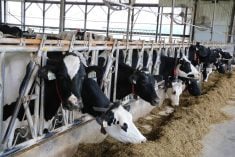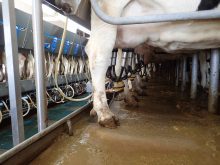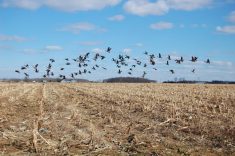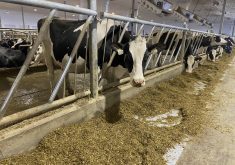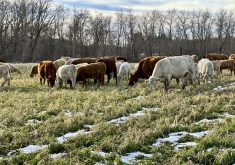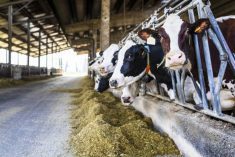Veterinarians and food safety officials have been scrambling for about a month to understand the origin and spread of highly pathogenic avian influenza in U.S. dairy herds across several states.
Many potential vectors have been considered, from migratory birds, direct cow-to-cow transmission and milking equipment. A University of Guelph veterinary professor has one word to describe this flu strain: erratic.
“We’ve never seen anything like this before — never, ever, ever,” said Shayan Sharif.
Read Also

Seeding Indigenous agricultural prosperity
National Circle for Indigenous Agriculture and Food says Indigenous agricultural success needs strong relationships.
He’s been following this iteration of bird flu, caused by the virus H5N1, since it started making global waves around 2020.
Why it matters: The American Association of Bovine Practitioners says cattle cases should be referred to as bovine influenza A virus (BIAV) to reflect that the disease is less lethal and presents with different symptoms in cattle than in poultry.
Since 2022, and until dairy cases were confirmed in March, the main struggle has involved poultry. Barn infections in the U.S. and Canada led millions of chickens and turkeys to be culled in the last few years in efforts to control spread.
“Globally, we’ve never seen an aviation outbreak that has lasted for almost three years globally and has caused so much pain for the poultry industry. It’s behaving very erratically,” Sharif said.
Wild mammals, mostly predators, have also been infected, as has a juvenile goat in Minnesota.
Start of the dairy problem
On April 16, an update from the USDA’s Animal and Plant Health Inspection Service indicated that they’ve so far found the virus in pigeons, grackles and blackbirds that live around dairy barns. That’s somewhat of a departure from the last few years, where birds like geese and other waterfowl were flagged as major disease reservoirs of concern.
The illness has killed several barn cats, caused a mild infection in one Texas dairy employee, and resulted in either positive or presumed positive tests on dairy cows in eight states: Kansas, Texas, New Mexico, North Carolina, South Dakota, Ohio, Idaho and Michigan.
Dr. Jean-Pierre Vaillaincourt, an epidemiologist with University of Montreal’s Faculty of Veterinary Medicine, says influenza A virus doesn’t spread readily in feces, so chances are low that geese or ducks could infect cows during a fly-over. It also doesn’t spread easily through nasal droplets so the likelihood is low that cows would spread the virus to other cows.
However, those vectors can’t be ruled out, he said, and there is much to investigate about current infections. Vaillaincourt thinks an infected bird with access to cattle housing or feeding areas likely contaminated either feed or water in the U.S. dairy incidents.
Reports show that USDA officials “floated the possibility, without naming specific herds or locations, that all affected cows may trace back to a single farm.”
Vaillaincourt believes this means positive tests in other states resulted from cattle imported from Texas, a fact confirmed in some U.S. cases. He says it’s likely HPAI was circulating in dairy facilities in Texas and possibly in nearby states for several weeks before someone decided to test for it.
“(The infection in cows) is noticeable, but it’s not really a classic case of anything … (and) they seem to recover after two weeks. They may have, in several states, had a problem for quite some time and they didn’t know.”
Vectors
The lone human case linked to dairy infections almost certainly occurred through milk contact, most likely splashing into eyes or being introduced into eyes by contaminated hands.
“Right now, the (U.S.-based) Centers for Disease Control in the U.S. is recommending people wear goggles” while dealing with infected cows, and urging against feeding raw milk to either humans or calves, Vaillaincourt said.
In Canada, sale of raw milk for human consumption is prohibited.
That’s likely not the link for new cattle infections, however. Cows don’t typically get milk in their eyes or noses and won’t knowingly eat a dead bird. But they could consume organic matter from a bird if it’s in feed or a water source.
“Water will be a big (subject of investigation),” Vaillaincourt said. “In non-treated water, this virus could survive for weeks.”
A possible cow-to-cow infection was tagged in Idaho March 30. The USDA later said it hasn’t seen “any true indication” the virus is spread that way. However, an April 24 statement, in which the agency announced new rules for interstate dairy cattle movement, said spread had been noted between cows in the same herd, from cows to poultry, between dairies associated with cattle movements and that virus had been found in cows without clinical signs.
In one case, lung tissue from a cull cow from an affected farm tested positive, although U.S. officials stressed no product from that cow made it into the food supply.
The Meat Institute, which speaks for American meat processors, has since called for the USDA to institute testing for beef.
Milking equipment is another potential vulnerability and some biosecurity recommendations also suggest rodent prevention.
“Rodents are not necessarily the best host for avian influenza, but it is possible that they could carry avian influenza into the barn,” Sharif said.
Why is this time different?
Migratory birds are the typical culprits blamed for bird flu spread. They are carriers but, in outbreaks prior to the explosion of cases in 2022, often didn’t develop signs of serious illness. This time round, that’s not the case.
“We’ve had massive die-offs of Canada geese caused by this particular strain of HPAI,” Sharif said. “In the past we wouldn’t have this (range) of behaviours displayed by the virus.”
In an April Reuters article, University of Guelph pathobiology researcher Nitish Boodhoo noted the strain infecting American cattle “has undergone a specific adaptation in an enzyme called polymerase. Changes to this viral enzyme are concerning, as it could allow for faster adaptation and maybe even support cattle-to-cattle transmission.”
In a statement reported by Reuters April 24, the USDA said it “has not found changes to the virus that would make it more transmissible to humans and between people.”
Canadian response
In an email, the Canadian Food Inspection Agency said it is “currently monitoring how this virus has been transmitted between different species and why it is affecting some mammals differently than others.
“The CFIA is working with the USDA, public health authorities, Canada’s veterinary community, industry and the provinces and territories to monitor the situation closely.”
Beef and dairy producers on both sides of the international border have also been told to bolster biosecurity and watch for signs of infections, such as reductions in milk production or feed uptake.
There is also concern that Canada is not totally prepared if BIAV jumps the border. There is no precedent here for such a mild infection, albeit one with possible wider-scale repercussions, Vaillancourt said.
A major dairy show is scheduled soon in Quebec and numerous bovine guests are expected to cross the border from the U.S.
“We don’t have a process right now that would require those cattle be tested for avian influenza,” he said.
Without a process in place, should all U.S. visitors be turned back? Alternatively, if a testing process is put in place, what should happen if there’s a positive test? Should cows be quarantined?
“CFIA is not going to go and investigate these things. They don’t have the manpower. They already don’t have all the resources they need to cover poultry,” said Vaillancourt.
The CFIA said that if symptoms appear on dairy farms, farmers should contact a veterinarian to have samples tested. If positive for BIAV, it must be reported to the CFIA. That agency and Health Canada are watching for signs that the strain is zoonotic.
“If we had dead cows in the U.S., this would be a very different story,” said Vaillancourt.
That would lead agencies on both sides of the border to implement biosecurity measures to preserve dairy cattle health. Officials in both countries remain on guard.
“It is one more species that can be infected, and the more the virus can cycle within different species, the more it has a chance to mutate,” Vaillancourt said.




